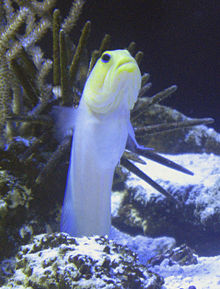| Yellowhead jawfish | |
|---|---|

| |
| Conservation status | |
 Least Concern (IUCN 3.1) | |
| Scientific classification | |
| Domain: | Eukaryota |
| Kingdom: | Animalia |
| Phylum: | Chordata |
| Class: | Actinopterygii |
| Order: | Blenniiformes |
| Family: | Opistognathidae |
| Genus: | Opistognathus |
| Species: | O. aurifrons |
| Binomial name | |
| Opistognathus aurifrons (D. S. Jordan & J. C. Thompson, 1905) | |
| Synonyms | |
| |
The yellowhead jawfish (Opistognathus aurifrons) is a species of jawfish native to coral reefs in the Caribbean Sea. It is found at depths of from 3 to 40 metres (9.8 to 131.2 ft). The head and upper body are a light, but brilliant, yellow color slowly fading to a pearlescent blue hue. It can reach a length of 10 centimetres (3.9 in) TL. Yellowhead jawfishes are common in Florida. The Jawfishes live in rubble areas and sand in groups of up to 70 individuals.
The yellowhead jawfish is usually found in shallows where materials are available for burrow construction. It remains near its relatively small territory, and is typically seen with only the head and upper section of its body protruding from its burrow, although it sometimes can be found hovering nearby. It is able to arrange material using its mouth, carrying sand, shells, or small rocks from one location to another.
It is a mouthbrooder, with the male carrying the eggs in its mouth until they hatch.
Yellowhead jawfish have two different types of responses to intruders, flight or fight. The type of response depends on the type of incoming fish. During flight, the fish will swim away from the intruder and in go into their burrow, covering the opening with a large rock. During fight, the fish will spit sand or rocks at the intruder.
In captivity
In the aquarium it feeds on planktonic matter, commonly taking brine shrimp, mysis shrimp, and prepared frozen and pelleted fish food. When other fish come near its territory, it will open its jaw wide and try to warn them off, but it rarely attacks. It is one of the most docile jawfish towards fish of its kind, and can be kept in small groups of 1 individual per 10 gallons.
References
- Smith-Vaniz, W.F.; Williams, J.T.; Curtis, M.; Pina Amargos, F.; Brown, J. (2015). "Opistognathus aurifrons". IUCN Red List of Threatened Species. 2015: e.T190079A16510687. doi:10.2305/IUCN.UK.2015-2.RLTS.T190079A16510687.en. Retrieved 20 November 2021.
- Froese, Rainer; Pauly, Daniel (eds.). "Opistognathus aurifrons". FishBase. February 2014 version.
- Robinson, Mary (2017-08-21). "Marine Fishes of FloridaRR 2017/170 Marine Fishes of Florida David B. Snyder and George H. Burgess Johns Hopkins University Press Baltimore, MD 2016 ix + 373 pp. ISBN 978 1 4214 1872 8 (print); ISBN 978 1 4214 1873 5 (e-book) £26 $39.95". Reference Reviews. 31 (6): 30–31. doi:10.1108/rr-04-2017-0087. ISSN 0950-4125.
- Colin, P. (1971). Interspecific relationships of yellowhead jawfish, opistognathus-aurifrons(pisces, opistognathidae). Copeia., 3, 469.
External links
- Photos of Yellowhead jawfish on Sealife Collection
| Taxon identifiers | |
|---|---|
| Opistognathus aurifrons | |
This order Gobiiformes (goby) related article is a stub. You can help Misplaced Pages by expanding it. |